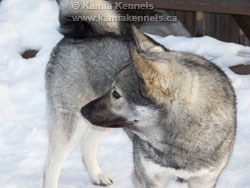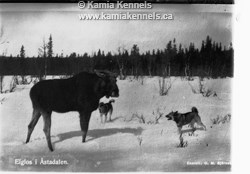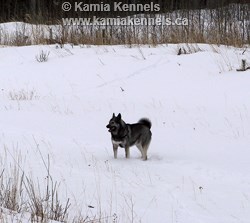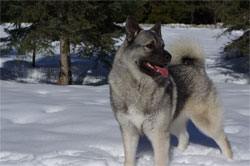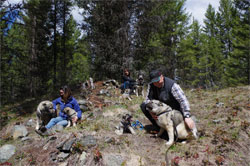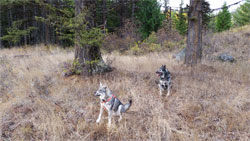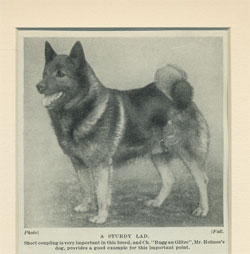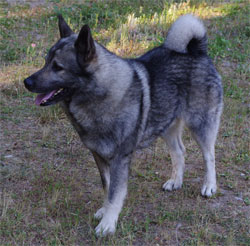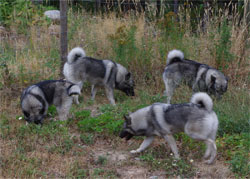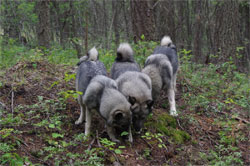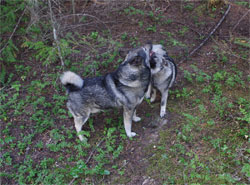Takoda - Ancient "Norrland" Swedish Elkhound in Canada
I will try to share a bit today about the ancient contribution to
the Norwegian Elkhound Gene pool by the old Norrland Elkhounds (
more formally known as the Swedish Elkhound) that roamed through
Sweden for centuries.
When we think today of the Norwegian Elkhound our thoughts of
course for good reason believe that the founding of the Norwegian
Elkhound was "Norway". Which in fact was a huge contribution to the
genetic pool, no doubt. But for hundreds of years long before the
Norwegian Kennel Club was even thought to be formed there existed
hunting dogs in all of Scandinavia. These hunting dogs all
contributed to the formation of the founding dogs that make up the
"Norwegian Elkhound" as we know it today. Norway, Sweden, Finland,
Denmark all contributed.
Representatives of the grey hunting dog were found in all regions
and in the country of Sweden two types were found, one the great
Grahund, which is a very close representation of the Norwegian
Elkhound of today and is what the Swedish Kennel Club based their
standard for the "Norwegian Elkhound" upon, the other a slightly
taller, sometimes darker type called the Norrland.
"The Norrland is what is believed to have contributed to
the creation thousands of years ago to the Swedish Elkhounds known
today called the Jämthund."
As a preservation breeder, meaning we breed to keep ancient
lineages intact and flourishing we still salute and breed the
Norrland dog ideal. I have to note that the ideals, structure style
and type of the Norrland is no longer compatible with the revised
and rewritten Norwegian Elkhound Breed Standard.
So thus the reason our dogs DO NOT in most cases meet or match
the breed standard. Nor do we try with most of our lineages. It's
only with our "Norwegian Elkhound lineages" with no known late blood
other than Norwegian that we "Breed to Norwegian Elkhound Standard".
For years breeders really without knowing have been breeding out
the Norrland genetics that contributed a huge amount to the early
foundation Elkhounds. Many say the superior athletic ability, the
long distance capability in particular of the taller rangier type
assisted those early foundation Elkhounds. What has been happening
though as the standards are rewritten to get a more uniform
appearance the taller rangier dogs have been bred out.
Breeders have been moving away from keeping all the genetic
diversity and have been moving toward a more concise looking dog,
focusing a fair bit of the breeding on the "Look" that matches, all
the while trying to maintain the original hunting aspects.
By focusing so much on this "look" the taller leaner dogs, lots
had white in the chest, around the lower jaw some times, and many
were much dark overall with longer guard hairs, these dogs were
thought by the "Unknowing" to be undesirable. The original standard
of course established at the very beginning acknowledged these
traits and were welcome, but todays standards do not.
So over the years the types have not been kept up in the
mainstream show breeding establishments in North America
particularly.
Here almost all breeders have lost focus on true genetic
diversity for a pursuit of a certain look and style.
At Kamia Kennels we strive to keep those old lineages intact. We
feel it strengthens the genetic make-up, keeps the gene pool much
larger, and with a larger gene pool comes less risk of genetic
issues. Also Canada has a great deal of the same regional typography
that the old countries have, and of course this means a great deal
of snow. The snow was one of the underlying reasons for selecting
over the decades the taller dogs. Now they are not overally much
taller, but are taller. An inch or two in deep snow means a much
safer hunt and allows the dog to hunt longer into the season if need
be.
Now it's also very easy to understand from a judging standpoint
why they rewrote the Norwegian Elkhound Breed standard and why "Show
Breeders" wish to utlize only lineages that conform to that. They of
course could not "win" if they are outside the standards. It was
difficult for the early Clubs to come to an agreement, from the
formation of the first show in 1877 it took until 1937 for the
Swedish and the Norwegian Kennel Clubs to agree to having 1 unified
common standard that would be used for the Grey Norwegian Elkhound.
But as a preservation breeder we don't have those concerns
foremost, we already know our dogs are going to be larger in many
cases, we know most certainly taller and longer, and in a lot of
situations on some lines, much darker. So for us, the "look" in our
ancient lineages is not the primary goal. The goal is to breed
healthy ancient genetics that have all the instincts intact with as
much genetic diversity as possible.
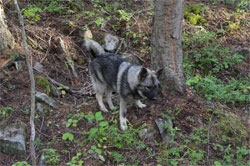 A
prime example of a full blood all instinct intact young female pup
that is a true purist in terms of genetics would be young Vida shown
at 5 months. Vida is exactly what was used say 300 years ago to hunt
and find game and assist the old woodsmen especially in hunting
season, but throughout the year as well. Vida is a daughter of
Takoda and GAEDA. She represents everything about an ideal Elkhound
through all the genetics and the related health aspects. Her
balance, the movements and gait, structure and much more. Her
temperment and personality along with her mental stability.
Everything literally is perfect. And she is as wide a genetic range
with as much diversity as could be found in an Elkhound female in
North America today.
A
prime example of a full blood all instinct intact young female pup
that is a true purist in terms of genetics would be young Vida shown
at 5 months. Vida is exactly what was used say 300 years ago to hunt
and find game and assist the old woodsmen especially in hunting
season, but throughout the year as well. Vida is a daughter of
Takoda and GAEDA. She represents everything about an ideal Elkhound
through all the genetics and the related health aspects. Her
balance, the movements and gait, structure and much more. Her
temperment and personality along with her mental stability.
Everything literally is perfect. And she is as wide a genetic range
with as much diversity as could be found in an Elkhound female in
North America today.
But she would not conform to the "Breed Standard" because of her
looks. She would be just slightly taller, slightly longer, and of
course darker. Outside of those three little aspects she is a far
superior dog in all respects. So do we "Worry About" that
little bit of height or length or dark color, of course not, we in
fact cherish it. We know the background of this female, we know that
with her here now we get another chance to preserve the ancient
bloodlines that ran in the old county centuries ago.
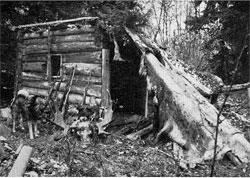 I
found an old photo, I apologize I can't remember where I got it, I
have had it for a long time or I would say where I got it, but no
matter, it is a really great old photo of an ancient ancestor to
Vida. You'll clearly be able to see all the things I was discussing
in this old photo of this great hunting Elkhound.
I
found an old photo, I apologize I can't remember where I got it, I
have had it for a long time or I would say where I got it, but no
matter, it is a really great old photo of an ancient ancestor to
Vida. You'll clearly be able to see all the things I was discussing
in this old photo of this great hunting Elkhound.
In the old times the dogs were bred by abilities, not by color or
standard etc. Thus the reason that the big Swedish Elkhounds were
kept in fairly remote regions, primarily as pure hunting dogs. The
Jamtland Province of Sweden had a great collection of the big
Swedish dogs, known to have had little influence in breeding with
any of the smaller grey's for hundreds of years if not longer. It
was this tight group of what is called the founding strain of
Swedish Elkhounds that were selected to enter the Association.
However the Norrland for hundreds of years had been used as a
hunting and breeding dog and the influence was found in the Grahund,
and a very dominant genetic makeup it was.
Today we still see judges commenting about the white on the chest
and to "Watch out for it" as it's difficult to get out. Preferrably
the standard would describe it not there in your dog. Other features
of course that are constantly monitored in today's show world is the
size. Dogs outside the size are not acceptable.
When I attended the big show in Finland and was watching the
Norwegian Elkhounds coming through, I noticed a judge take a
"painted plywood Elkhound" and stand it beside an entry. The dog was
just larger than this "Sized Elkhound" which is used as a quick and
very easy way to measure size. I know there is a name for this tool,
I just don't know it. But what I found interesting is that the dog
that was there was a stunning dog. It had completed it's hunting
trials and had excelled. It was now going to try to win in show
competition. But here literally 100+ years after the standard, the
larger dogs are still showing up so much so they have a ready
measurement procedure to gauge quickly these larger dogs.
It should be noted that in hunting trials the size is not a
concern, thus he was able to come to the "Show" as he had been
qualified in work.
So the old Grahund/Norrland influence is still evident in
Finland, Sweden and Norway, along with Canada and the USA, UK and
others.
Today you can still have a "Grahund/Norrland/Swedish" influenced
dog, who is actually "Registered As A Norwegian Elkhound".
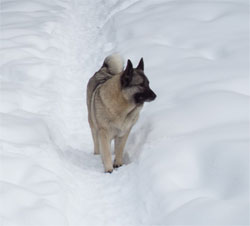 GAEDA is a prime example of this today. She is a stunning female and
an absolute pleasure to be around. But here is the thing, she is a
big female. She is 60+ pounds and taller and longer than the
standard. She has the slightly finer bone density the Swedish dogs
have, she also has the loose curl tail and she has the slightly
taller ears. Most judges who don't really know the Grahund/Norrland
based Norwegian Elkhound lines would discredit her few features. But
GAEDA is actually a superior example of a true Norwegian Elkhound as
she retains a much more diverse set of genetics and contributes a
whole different set of traits and DNA to the gene pool. A female
like GAEDA is extremely valuable to the entire population of the
Norwegian Elkhound and dogs like her need to have greater value for
the overall benefit and quality to the breed than simply just
"Looks". Take a look through the site and view her pups, what
an outstanding group. And look at the "old genetic style" that she
can bring out. Syn a great example, Desna, another. Vendela, Vuk,
Hanna, there are so many more examples, all superior Elkhounds. So
for us when people ask why our dogs are a bit larger, why we are
breeding dogs that are obviously outside the standard in some cases,
this article hopefully will help them understand that genetic
diversity has existed in this breed long before the Associations and
Breed Standards and we will strive to maintain that.
GAEDA is a prime example of this today. She is a stunning female and
an absolute pleasure to be around. But here is the thing, she is a
big female. She is 60+ pounds and taller and longer than the
standard. She has the slightly finer bone density the Swedish dogs
have, she also has the loose curl tail and she has the slightly
taller ears. Most judges who don't really know the Grahund/Norrland
based Norwegian Elkhound lines would discredit her few features. But
GAEDA is actually a superior example of a true Norwegian Elkhound as
she retains a much more diverse set of genetics and contributes a
whole different set of traits and DNA to the gene pool. A female
like GAEDA is extremely valuable to the entire population of the
Norwegian Elkhound and dogs like her need to have greater value for
the overall benefit and quality to the breed than simply just
"Looks". Take a look through the site and view her pups, what
an outstanding group. And look at the "old genetic style" that she
can bring out. Syn a great example, Desna, another. Vendela, Vuk,
Hanna, there are so many more examples, all superior Elkhounds. So
for us when people ask why our dogs are a bit larger, why we are
breeding dogs that are obviously outside the standard in some cases,
this article hopefully will help them understand that genetic
diversity has existed in this breed long before the Associations and
Breed Standards and we will strive to maintain that.
Deep Snow Conditioning For
Elkhounds
Elkhound Conformation
For Athletic Ability
An Offleash Winter Hiking
Adventure With Elkhounds
